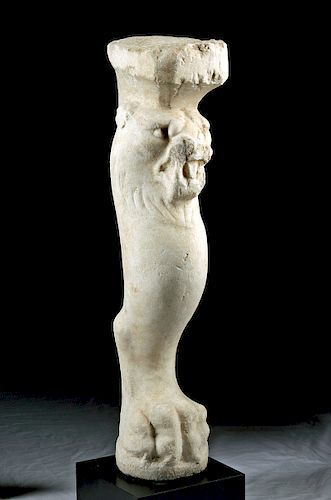Massive Roman Marble Furniture Leg Lion, Head / Paw
Lot 82
About Seller
Artemis Fine Arts
686 S Taylor Ave, Ste 106
Louisville, CO 80027
United States
Selling antiquities, ancient and ethnographic art online since 1993, Artemis Gallery specializes in Classical Antiquities (Egyptian, Greek, Roman, Near Eastern), Asian, Pre-Columbian, African / Tribal / Oceanographic art. Our extensive inventory includes pottery, stone, metal, wood, glass and textil...Read more
Estimate:
$15,000 - $25,000
Absentee vs Live bid
Two ways to bid:
- Leave a max absentee bid and the platform will bid on your behalf up to your maximum bid during the live auction.
- Bid live during the auction and your bids will be submitted real-time to the auctioneer.
Bid Increments
| Price | Bid Increment |
|---|---|
| $0 | $25 |
| $300 | $50 |
| $1,000 | $100 |
| $2,000 | $250 |
| $5,000 | $500 |
| $10,000 | $1,000 |
| $20,000 | $2,500 |
| $50,000 | $5,000 |
| $100,000 | $10,000 |
| $200,000 | $20,000 |
About Auction
By Artemis Fine Arts
Feb 21, 2019
Set Reminder
2019-02-21 10:00:00
2019-02-21 10:00:00
America/New_York
Bidsquare
Bidsquare : Exceptional Antiquities, Asian, Ethnographic
https://www.bidsquare.com/auctions/artemis-gallery/exceptional-antiquities-asian-ethnographic-3858
An important one-day auction featuring museum-worthy examples of Egyptian, Greek, Roman, Etruscan, Near Eastern, Far East / Asian, Pre-Columbian, African / Tribal, Oceanic, Native American, Spanish Colonial, Russian, Fossils, Ancient Jewelry, Fine Art, so much more! Artemis Fine Arts info@artemisgallery.com
An important one-day auction featuring museum-worthy examples of Egyptian, Greek, Roman, Etruscan, Near Eastern, Far East / Asian, Pre-Columbian, African / Tribal, Oceanic, Native American, Spanish Colonial, Russian, Fossils, Ancient Jewelry, Fine Art, so much more! Artemis Fine Arts info@artemisgallery.com
- Lot Description
Roman, Imperial Period, ca. 2nd century CE. A handsome, large marble table leg, also known as a trapezophoron, with a giant clawed foot, leg joint, and smooth body that widens to a fierce lion's head. The mane is carved onto the leg below the lion's projecting snout and radiates outward around the heavy head, which features small ears, deepset eyes, a furrowed brow, and a mouth full of sharp teeth with the tongue between them. Above and behind the lion is a plinth and support. Imagine the size and grandeur of the table that this leg once supported! Size: 8.1" L x 6.75" W x 30.25" H (20.6 cm x 17.1 cm x 76.8 cm); 33.75" H (85.7 cm) on included custom stand.
Feline-headed table supports were a sign of wealth and refinement in ancient Rome, and several examples of different styles are known, although most, unlike this one, have been restored. Perhaps the most famous are the three found with a round marble tabletop in the house of Cornelius Rufus in Pompeii, which stood behind the impluvium, the area of a Roman house usually lined with marble and designed to carry away rainwater. Tables like this one were designed to support a display of vases, oil lamps, and other household treasures. These legged tables were not always tripods - other examples found at Pompeii were two- and four-legged. Fascinatingly, many of these table legs - the ones not frozen in time by volcanic eruptions - took on a life of their own, long after their original owners commissioned them. For example, some have been found from the medieval period in cities that were not in existence during the Roman period, no doubt carried there by people who found the ruins of a Roman villa and were struck by the beauty of the Roman's artwork.
c. f., "Fortuna Fine Arts, Ltd. "Reflections of the Past", 2001, pg. 39; a more dramatic but partially restored example at Christie's that sold in 2008 for GBP 84,500 (approximately USD 110,000): https://www.christies.com/lotfinder/Lot/a-roman-marble-table-leg-in-the-5066993-details.aspx; a similar but restored example at the British Museum: https://www.britishmuseum.org/research/collection_online/collection_object_details.aspx?objectId=459865&partId=1&searchText=Trapezophoron&page=1; and another of very similar style made of black basalt at the Fitzwilliam Museum, Cambridge, UK: http://webapps.fitzmuseum.cam.ac.uk/explorer/index.php?qu=roman%20lion%20leg&oid=65544
Provenance: private East Coast, USA collection; ex-Joe Gerena Fine Arts, New York, USA, acquired in the 1990s
All items legal to buy/sell under U.S. Statute covering cultural patrimony Code 2600, CHAPTER 14, and are guaranteed to be as described or your money back.
A Certificate of Authenticity will accompany all winning bids.
We ship worldwide and handle all shipping in-house for your convenience.
#143887Intact and unrestored. Weathered surface with some light deposits. Losses to upper plinth and the lion's snout, with surface wear commensurate with age overall.Condition
- Shipping Info
-
All shipping is handled in-house for your convenience. Your invoice from Artemis Gallery will include shipping calculation instructions. If in doubt, please inquire BEFORE bidding for estimated shipping costs for individual items.
-
- Buyer's Premium



 EUR
EUR CAD
CAD AUD
AUD GBP
GBP MXN
MXN HKD
HKD CNY
CNY MYR
MYR SEK
SEK SGD
SGD CHF
CHF THB
THB
















